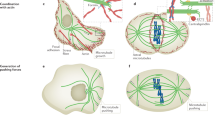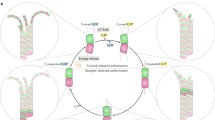Abstract
Microtubules are known to drive chromosome movements and to induce nuclear envelope breakdown during mitosis and meiosis. Here we show that microtubules can enforce nuclear envelope folding and alter the levels of nuclear envelope-associated heterochromatin during interphase, when the nuclear envelope is intact. Microtubule reassembly, after chemically induced depolymerization led to folding of the nuclear envelope and to a transient accumulation of condensed chromatin at the site nearest the microtubule organizing center (MTOC). This microtubule-dependent chromatin accumulation next to the MTOC is dependent on the composition of the nuclear lamina and the activity of the dynein motor protein. We suggest that forces originating from simultaneous polymerization of microtubule fibers deform the nuclear membrane and the underlying lamina. Whereas dynein motor complexes localized to the nuclear envelope that slide along the microtubules transfer forces and/or signals into the nucleus to induce chromatin reorganization and accumulation at the nuclear membrane folds. Thus, our study identified a molecular mechanism by which mechanical forces generated in the cytoplasm reshape the nuclear envelope, alter the intranuclear organization of chromatin, and affect the architecture of the interphase nucleus.







Similar content being viewed by others
References
Salina D, Bodoor K, Eckley DM, Schroer TA, Rattner JB, Burke B (2002) Cytoplasmic dynein as a facilitator of nuclear envelope breakdown. Cell 108(1):97–107. pii:S0092867401006286
Beaudouin J, Gerlich D, Daigle N, Eils R, Ellenberg J (2002) Nuclear envelope breakdown proceeds by microtubule-induced tearing of the lamina. Cell 108(1):83–96. pii:S0092867401006274
Burke B, Ellenberg J (2002) Remodelling the walls of the nucleus. Nat Rev Mol Cell Biol 3(7):487–497. doi:10.1038/nrm860
Gatlin JC, Bloom K (2010) Microtubule motors in eukaryotic spindle assembly and maintenance. Semin Cell Dev Biol 21(3):248–254. doi:10.1016/j.semcdb.2010.01.015
Walczak CE, Cai S, Khodjakov A (2010) Mechanisms of chromosome behaviour during mitosis. Nat Rev Mol Cell Biol 11(2):91–102. doi:10.1038/nrm2832
Hiraoka Y, Dernburg AF (2009) The SUN rises on meiotic chromosome dynamics. Dev Cell 17(5):598–605. doi:10.1016/j.devcel.2009.10.014
Zhang X, Lei K, Yuan X, Wu X, Zhuang Y, Xu T, Xu R, Han M (2009) SUN1/2 and Syne/Nesprin-1/2 complexes connect centrosome to the nucleus during neurogenesis and neuronal migration in mice. Neuron 64(2):173–187. doi:10.1016/j.neuron.2009.08.018
Malone CJ, Misner L, Le Bot N, Tsai MC, Campbell JM, Ahringer J, White JG (2003) The C. elegans hook protein, ZYG-12, mediates the essential attachment between the centrosome and nucleus. Cell 115(7):825–836. S0092867403009851 [pii]
Fischer JA, Acosta S, Kenny A, Cater C, Robinson C, Hook J (2004) Drosophila klarsicht has distinct subcellular localization domains for nuclear envelope and microtubule localization in the eye. Genetics 168(3):1385–1393. doi:10.1534/genetics.104.028662
Roux KJ, Crisp ML, Liu Q, Kim D, Kozlov S, Stewart CL, Burke B (2009) Nesprin 4 is an outer nuclear membrane protein that can induce kinesin-mediated cell polarization. Proc Natl Acad Sci USA 106(7):2194–2199. doi:10.1073/pnas.0808602106
Fridolfsson HN, Ly N, Meyerzon M, Starr DA (2010) UNC-83 coordinates kinesin-1 and dynein activities at the nuclear envelope during nuclear migration. Dev Biol 338(2):237–250. doi:10.1016/j.ydbio.2009.12.004
Wilson KL, Berk JM (2010) The nuclear envelope at a glance. J Cell Sci 123(Pt 12):1973–1978. doi:10.1242/jcs.019042
Starr DA, Fridolfsson HN (2010) Interactions between nuclei and the cytoskeleton are mediated by SUN-KASH nuclear-envelope bridges. Annu Rev Cell Dev Biol 26:421–444. doi:10.1146/annurev-cellbio-100109-104037
Mejat A, Misteli T (2010) LINC complex in health and disease. Nucleus 1(1):40–52
Mattout A, Goldberg M, Tzur Y, Margalit A, Gruenbaum Y (2007) Specific and conserved sequences in D. melanogaster and C. elegans lamins and histone H2A mediate the attachment of lamins to chromosomes. J Cell Sci 120(Pt 1):77–85. doi:10.1242/jcs.03325
Taniura H, Glass C, Gerace L (1995) A chromatin binding site in the tail domain of nuclear lamins that interacts with core histones. J Cell Biol 131(1):33–44
Kubben N, Voncken JW, Demmers J, Calis C, van Almen G, Pinto Y, Misteli T (2010) Identification of differential protein interactors of lamin A and progerin. Nucleus 1(6):513–525. doi:10.4161/nucl.1.6.13512
Guelen L, Pagie L, Brasset E, Meuleman W, Faza MB, Talhout W, Eussen BH, de Klein A, Wessels L, de Laat W, van Steensel B (2008) Domain organization of human chromosomes revealed by mapping of nuclear lamina interactions. Nature 453(7197):948–951. doi:10.1038/nature06947
Polioudaki H, Kourmouli N, Drosou V, Bakou A, Theodoropoulos PA, Singh PB, Giannakouros T, Georgatos SD (2001) Histones H3/H4 form a tight complex with the inner nuclear membrane protein LBR and heterochromatin protein 1. EMBO Rep 2(10):920–925. doi:10.1093/embo-reports/kve199
Montes de Oca R, Lee KK, Wilson KL (2005) Binding of barrier to autointegration factor (BAF) to histone H3 and selected linker histones including H1.1. J Biol Chem 280(51):42252–42262. doi:10.1074/jbc.M509917200
Antoniacci LM, Kenna MA, Skibbens RV (2007) The nuclear envelope and spindle pole body-associated Mps3 protein bind telomere regulators and function in telomere clustering. Cell Cycle 6(1):75–79
Chikashige Y, Tsutsumi C, Yamane M, Okamasa K, Haraguchi T, Hiraoka Y (2006) Meiotic proteins bqt1 and bqt2 tether telomeres to form the bouquet arrangement of chromosomes. Cell 125(1):59–69. doi:10.1016/j.cell.2006.01.048
Conrad MN, Lee CY, Wilkerson JL, Dresser ME (2007) MPS3 mediates meiotic bouquet formation in Saccharomyces cerevisiae. Proc Natl Acad Sci USA 104(21):8863–8868. doi:10.1073/pnas.0606165104
King MC, Drivas TG, Blobel G (2008) A network of nuclear envelope membrane proteins linking centromeres to microtubules. Cell 134(3):427–438. doi:10.1016/j.cell.2008.06.022
Gerlitz G, Livnat I, Ziv C, Yarden O, Bustin M, Reiner O (2007) Migration cues induce chromatin alterations. Traffic 8(11):1521–1529. doi:10.1111/j.1600-0854.2007.00638.x
Dahl KN, Scaffidi P, Islam MF, Yodh AG, Wilson KL, Misteli T (2006) Distinct structural and mechanical properties of the nuclear lamina in Hutchinson-Gilford progeria syndrome. Proc Natl Acad Sci USA 103(27):10271–10276. doi:10.1073/pnas.0601058103
Quintyne NJ, Schroer TA (2002) Distinct cell cycle-dependent roles for dynactin and dynein at centrosomes. J Cell Biol 159(2):245–254. doi:10.1083/jcb.200203089
Gonda MA, Aaronson SA, Ellmore N, Zeve VH, Nagashima K (1976) Ultrastructural studies of surface features of human normal and tumor cells in tissue culture by scanning and transmission electron microscopy. J Natl Cancer Inst 56(2):245–263
Daigle N, Beaudouin J, Hartnell L, Imreh G, Hallberg E, Lippincott-Schwartz J, Ellenberg J (2001) Nuclear pore complexes form immobile networks and have a very low turnover in live mammalian cells. J Cell Biol 154(1):71–84
Andres V, Gonzalez JM (2009) Role of A-type lamins in signaling, transcription, and chromatin organization. J Cell Biol 187(7):945–957. doi:10.1083/jcb.200904124
Dittmer TA, Misteli T (2011) The lamin protein family. Genome Biol 12(5):222. doi:10.1186/gb-2011-12-5-222
De Sandre-Giovannoli A, Bernard R, Cau P, Navarro C, Amiel J, Boccaccio I, Lyonnet S, Stewart CL, Munnich A, Le Merrer M, Levy N (2003) Lamin a truncation in Hutchinson–Gilford progeria. Science 300(5628):2055. doi:10.1126/science.1084125
Eriksson M, Brown WT, Gordon LB, Glynn MW, Singer J, Scott L, Erdos MR, Robbins CM, Moses TY, Berglund P, Dutra A, Pak E, Durkin S, Csoka AB, Boehnke M, Glover TW, Collins FS (2003) Recurrent de novo point mutations in lamin A cause Hutchinson-Gilford progeria syndrome. Nature 423(6937):293–298. doi:10.1038/nature01629
Verstraeten VL, Ji JY, Cummings KS, Lee RT, Lammerding J (2008) Increased mechanosensitivity and nuclear stiffness in Hutchinson-Gilford progeria cells: effects of farnesyltransferase inhibitors. Aging Cell 7(3):383–393. doi:10.1111/j.1474-9726.2008.00382.x
Hebbar S, Mesngon MT, Guillotte AM, Desai B, Ayala R, Smith DS (2008) Lis1 and Ndel1 influence the timing of nuclear envelope breakdown in neural stem cells. J Cell Biol 182(6):1063–1071. doi:10.1083/jcb.200803071
Busson S, Dujardin D, Moreau A, Dompierre J, De Mey JR (1998) Dynein and dynactin are localized to astral microtubules and at cortical sites in mitotic epithelial cells. Curr Biol 8(9):541–544. S0960-9822(98)70208-8 [pii]
Schroer TA (2004) Dynactin. Annu Rev Cell Dev Biol 20:759–779. doi:10.1146/annurev.cellbio.20.012103.094623
Kardon JR, Vale RD (2009) Regulators of the cytoplasmic dynein motor. Nat Rev Mol Cell Biol 10(12):854–865. doi:10.1038/nrm2804
Brandt A, Papagiannouli F, Wagner N, Wilsch-Brauninger M, Braun M, Furlong EE, Loserth S, Wenzl C, Pilot F, Vogt N, Lecuit T, Krohne G, Grosshans J (2006) Developmental control of nuclear size and shape by Kugelkern and Kurzkern. Curr Biol 16(6):543–552. doi:10.1016/j.cub.2006.01.051
Hampoelz B, Azou-Gros Y, Fabre R, Markova O, Puech PH, Lecuit T (2011) Microtubule-induced nuclear envelope fluctuations control chromatin dynamics in Drosophila embryos. Development 138(16):3377–3386. doi:10.1242/dev.065706
Smetana K, Mikulenkova D, Klamova H (2011) Heterochromatin density (condensation) during cell differentiation and maturation using the human granulocytic lineage of chronic myeloid leukaemia as a convenient model. Folia Biol (Praha) 57(5):216–221. pii: FB2011A0031
Bainton DF, Ullyot JL, Farquhar MG (1971) The development of neutrophilic polymorphonuclear leukocytes in human bone marrow. J Exp Med 134(4):907–934
Olins AL, Olins DE (2004) Cytoskeletal influences on nuclear shape in granulocytic HL-60 cells. BMC Cell Biol 5:30. doi:10.1186/1471-2121-5-30
Olins AL, Ernst A, Zwerger M, Herrmann H, Olins DE (2010) An in vitro model for Pelger-Huet anomaly: stable knockdown of lamin B receptor in HL-60 cells. Nucleus 1(6):506–512. doi:10.4161/nucl.1.6.13271
Olins AL, Herrmann H, Lichter P, Kratzmeier M, Doenecke D, Olins DE (2001) Nuclear envelope and chromatin compositional differences comparing undifferentiated and retinoic acid- and phorbol ester-treated HL-60 cells. Exp Cell Res 268(2):115–127. doi:10.1006/excr.2001.5269
Crisp M, Liu Q, Roux K, Rattner JB, Shanahan C, Burke B, Stahl PD, Hodzic D (2006) Coupling of the nucleus and cytoplasm: role of the LINC complex. J Cell Biol 172(1):41–53. doi:10.1083/jcb.200509124
Haque F, Lloyd DJ, Smallwood DT, Dent CL, Shanahan CM, Fry AM, Trembath RC, Shackleton S (2006) SUN1 interacts with nuclear lamin A and cytoplasmic nesprins to provide a physical connection between the nuclear lamina and the cytoskeleton. Mol Cell Biol 26(10):3738–3751. doi:10.1128/MCB.26.10.3738-3751.2006
Haque F, Mazzeo D, Patel JT, Smallwood DT, Ellis JA, Shanahan CM, Shackleton S (2010) Mammalian SUN protein interaction networks at the inner nuclear membrane and their role in laminopathy disease processes. J Biol Chem 285(5):3487–3498. doi:10.1074/jbc.M109.071910
Gregory WA, Edmondson JC, Hatten ME, Mason CA (1988) Cytology and neuron-glial apposition of migrating cerebellar granule cells in vitro. J Neurosci 8(5):1728–1738
Freitag M, Hickey PC, Raju NB, Selker EU, Read ND (2004) GFP as a tool to analyze the organization, dynamics and function of nuclei and microtubules in Neurospora crassa. Fungal Genet Biol 41(10):897–910. doi:10.1016/j.fgb.2004.06.008
Ingber DE (2006) Cellular mechanotransduction: putting all the pieces together again. FASEB J 20(7):811–827. doi:10.1096/fj.05-5424rev
Wang N, Tytell JD, Ingber DE (2009) Mechanotransduction at a distance: mechanically coupling the extracellular matrix with the nucleus. Nat Rev Mol Cell Biol 10(1):75–82. doi:10.1038/nrm2594
Acknowledgments
We thank Trina A. Schroer (Department of Biology, Johns Hopkins University, Baltimore, MD, USA), Michael W. Davidson (National High Magnetic Field Laboratory and Department of Biological Science, Florida State University, Tallahassee, FL, USA) and Tom Misteli (NCI, NIH, MD, USA) for providing the plasmids, Valarie A. Barr (LCMB, NCI, NIH) for help with the confocal microscopy, and Kunio Nagashima and Christina M. Burks (Electron Microscope Laboratory, Advanced Technology Program, SAIC-Frederick, Inc. NCI, NIH, Frederick, MD, USA) for help with the TEM analysis. This work was supported by the Intramural Research Program of the National Institutes of Health, Center for Cancer Research, National Cancer Institute.
Author information
Authors and Affiliations
Corresponding author
Electronic supplementary material
Below is the link to the electronic supplementary material.
Supplementary Movie 1 Microtubule recovery induces nuclear alterations. GFP fused histone H1E (chromatin marker) and Cherry fused EB3 (centrosome marker) overexpressing cells were treated with nocodazole to induce microtubule depolymerization. Following the nocodazole removal, the cells were imaged every minute by the DeltaVision system package (Applied Precision, Issaquah, WA, USA) for 50 min. The speed of the movie that was generated by the Imaris software (Bitplane, Zurich, Switzerland) is 4 frames per second. 2 min passed between the nocodazole removal and the acquisition of the first frame, therefore 2 min should be added to the acquisition time shown at the bottom left side of the frame. The scale bar is 8 μm.(AVI 726 kb)
Rights and permissions
About this article
Cite this article
Gerlitz, G., Reiner, O. & Bustin, M. Microtubule dynamics alter the interphase nucleus. Cell. Mol. Life Sci. 70, 1255–1268 (2013). https://doi.org/10.1007/s00018-012-1200-5
Received:
Revised:
Accepted:
Published:
Issue Date:
DOI: https://doi.org/10.1007/s00018-012-1200-5




